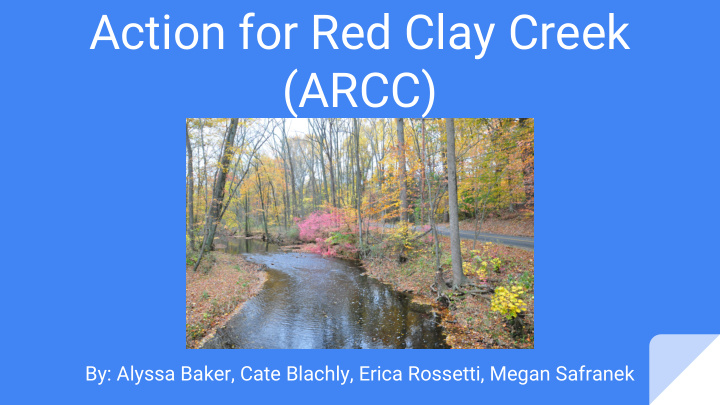



Action for Red Clay Creek (ARCC) By: Alyssa Baker, Cate Blachly, Erica Rossetti, Megan Safranek
● Background Overview ● History ● Mission Statement ● Three Problems, Goals, and their Solutions ● Existing Organizations and Regulations to aid us ● Conclusion/Timeline
Red Clay Creek: Background 54 square miles ● ● Part of Christina River Basin (in Delaware River Basin) Location: ● New Castle County, DE ○ ○ Chester County, PA ● Population: 47,000 Five subwatersheds ● Hoopes Reservoir ●
History ● Population increase Urbanization ● Flooding ● ● Land use changes
Mission Statement The goals of the Action for Red Clay Creek plan (ARCC) are: Attain the acceptable levels of TMDLs ● Improve water quality such that each water body is removed from the EPA ● 303d list of impaired streams ● Reduce flooding in the Red Clay Creek watershed by 50% Accomplish all goals by the year 2030 ●
Problem 1: Contaminants ● High levels of PCBs, dioxins, and chlorinated pesticides Toxic to humans and wildlife and bioaccumulate in fatty tissue ● Degrade water quality ● ● Sources: ○ point source discharges Industrial land runoff ○ Agricultural lands ○
Goal 1: Contaminants ● Reduce the presence of contaminants Meet fishable standards ● Identify point and nonpoint sources ● ● Enforce local, state, and federal regulations
Riparian Buffers ● Vegetative barrier separating water body from agricultural and industrial runoff Prevents contaminants from entering water ● body and absorbs excess nutrients ● Trees planted in plastic tubes to protect from wildlife and provide forested buffer Tree seedlings utilized to create buffer
Problem 2: Nutrients
Problem 2: Nutrients Nutrient of Concern Concentration Historical Trend Zinc Exceeds chronic and acute Decreasing state levels 85% of the time Phosphorus Exceeds EPA levels 90% of Decreasing the time Nitrogen Does not exceed standard Increasing Non-point nutrient sources: ● Agriculture: pastures and mushroom farms Silviculture ● ● Lawn Fertilization
Goal 2: Nutrients Reduce nutrient concentrations to state and EPA water quality standards by: Eutrophication education ● ○ Encourage reduction of fertilizer and use of alternative methods ● Incentive programs ○ Encourage farmers to implement best management solutions...
Precision Farming & Cover Crops Precision Farming ● Only apply fertilizer to crops that need it ● Decreases nutrient pollution in runoff Cover Crops Crops planted that remain through the winter ● Seeder used for precision farming ● Absorb excess nutrients and stabilize soil
Problem 3: Stormwater Runoff & Flooding ● Increase in development Historical increase in impervious area ● Issues with designated water use ● Red Clay Creek Flooding, October 1st 2010
Goal 3: Stormwater Runoff & Flooding ● Encouraging better municipal stormwater management and planning ● Educate the public on ways they can encourage infiltration
Bioretention Areas & Constructed Wetlands Bioretention Areas Shallow depressions that collect and filter ● runoff ● Promote infiltration and reduce overall runoff Constructed Wetlands ● Mimic natural wetlands Water contained as standing water on surface ● or saturated water just below soil surface
Existing Organizations* *not an exclusive list 1. Local municipalities (Five PA townships + New Castle County) 2. Brandywine Red Clay Alliance 3. Christina Basin Clean Water Partnership (CBCWP) 4. Delaware River Basin Commission (DRBC) 5. U.S. Environmental Protection Agency (EPA)
Existing Regulations ● Christina Basin TMDL Implementation Partnership Plan (CTIP) Total Maximum Daily Load (TMDLs) ● ● National Pollutant Discharge Elimination System (NPDES) Stormwater Management Act (PA Act 167) ●
Tentative Schedule Tentative Deadline Action(s) to be completed December 31st, 2017 ● Compile list of necessary sources, contacts, regulations, and standards (Preliminary) ● Begin compiling data December 31st, 2020 Identify, locate, and assess all point and ● nonpoint pollution sources and stormwater management systems (Identification) ● Identify other areas of highest concern December 31st, 2025 Have all programs in place, up, and running in ● order to meet ultimate requirements Reverse increasing nitrogen trends ● ● Have at least half of streams removed from EPA 303d list of impaired streams (Interim goals) ● Reduce flooding by 25% December 31st, 2030 Attain proper concentrations for TMDLs ● ● Reduce flooding by 50% Have each water body removed from EPA 303d ● (Final goals) list of impaired streams
Recommend
More recommend